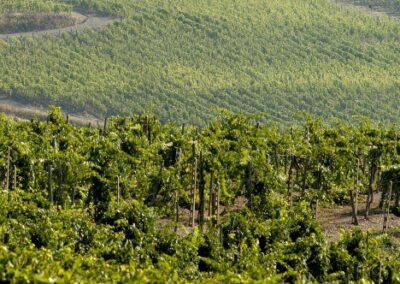Il Castello di Querceto
Learn about our past
Learn to love our land
Il Castello di Querceto
Learn about our past
Learn to love our land

Our past
Learn more

Coat of arms
Learn more

Family
Learn more

Neighbourhood
Learn more
The castle and its origins
Castello di Querceto was built to defend the neighbourhood. It stood as a sentinel along one of the major roads, in past times, the Imperial Roman Via Cassia road, that the Emperor Hadrian ordained in 123 AD. The castle stands amid the woodlands of this hill country, so typical of the Chianti district. The castle now stands as a vedette, or sentinel, over the estate’s vineyards and olive groves on the slopes of the valle di Dudda, stretching from passo del Sugame pass toward Lucolena and monte San Michele
The long L-shaped construction features a tower, this being a traditional feature of such buildings. The tower surmounts the central portion of the facade. We may note the old Guelphic battlements, recalling a medieval past of castle-building in an age of great historical significance and interest.

The castle today
Today’s castle dates back to the sixteenth century AD. The original medieval building was ransacked, burned to the ground and demolished at the close of the fifteenth century during one of the many wars fought during that period. Also destroyed was the settlement surrounding the castle.
The outer wall was practically entirely torn down. Only the part overlooking the valley remains today, serving as a support for structures added later.

Restoration work
Reconstruction commenced thanks to the initiative of the Canigiani family, then the owners of this property. The property was then purchased by the noted Pitti family and served as a summer retreat for many years.
The François family purchased the estate in 1897, a ‘hallmark’ or symbol of a longstanding Chianti Classico winemaking tradition.
Coat of arms
“Envy accompanies virtue”

Virtutis invidia comes
The François House’s coat of arms bears the motto, “virtutis invidia comes” (envy accompanies virtue). It features symbols and colours that attest to the history and attributes of the House:
azure field with gilt bend adorned with a centrally positioned eagle with wings outspread, flanked by two stars (with six red rays) and three gilt mounts (middle base).
Above, is the crest with escutcheon (shield), the helmet with its visor closed; the unicorn’s head is surmounted by a marquis’s crown.
Colours
The bend bearing the two stars and eagle is the symbol of the old Guelphic families. It also represent the order of knights and the upper ranks of the army.
The colour gold is the most noble. It symbolises strength faith, wealth and commanding authority.
Azure is the colour of the sky. It embodies many qualities: it stands for exalted ideas, ideas soaring endlessly upward. It signifies absolute rectitude, since the sky cannot be besmirched or altered. It signifies also glory, since it rises above our earthly concerns, and also virtue, since virtue is celestial.
Symbols
The eagle with wings outstretched, swooping, alludes to pride in one’s origins and an awareness of one’s social ranking. It also indicates Imperial favour, honours and beneficence.
The unicorn, symbolizes strength and the generosity of victory.
The three mounts of the coat of arms reflect the traditional Italian manner of representation of this element (capped cylinders forming a pyramidal arrangement). This stylistic feature indicates holdings, the number of which varies according to the number of mounts included. The motif probably also indicates the House’s old Haute-Savoie origins.
The stars symbolise a yearning for more exalted goals, sublime actions guided by the sure hand of those divine laws that have always favoured this House and its fortunes and prosperity. Furthermore, in Tuscany, stars attested to a family’s allegiance to the Guelphic cause.
The François House
1354
ORIGINS
- We find the first mention of the François family in Haute-Savoie
Learn more
1740
THE MOVE TO TUSCANY
- The family arrives in Tuscany, to serve the House of the Emperor
Learn more
1749
RANKING AS NOBLES
- The family is raised into the nobility
Learn more
1844
ALESSANDRO AND HIS JOURNEY OF DISCOVERY INTO ETRURIA
- Alessandro François’ major archaeological finds bring honour to the House
Learn more
1897
AGRICULTURE
- Carlo François purchases the Castello di Querceto estate
Learn more
1924
FOUNDERS OF THE CONSORZIO
- The family played a role in founding the winemakers’ association, Consorzio del Chianti Classico
Learn more
Today
THE FIFTH GENERATION
- The family and its business activities up to the present day
Learn more
Chianti Classico,
the charm of an unspoilt rural retreat
The area known as Chianti Classico is of unspoilt natural beauty. The landscape is a charmingly harmonious assortment of vineyards, olive groves, woodlands, scattered romantic farmsteads, verdant hill country and fascinating Medieval hamlets.
The district is much-loved by tourists “seeking a taste of the good life as lived in Tuscany”. Visitors are lulled by the region’s natural splendours and are delighted by the local foods and wines, faithful to our traditions.
The area covers about 70,000 hectares, astride the provinces of Florence and Siena.
Within the area are the municipalities of Greve in Chianti, Castellina in Chianti, Gaiole in Chianti and Radda in Chianti (in their entirety). In part, the area also hosts San Casciano in Val di Pesa, Barberino Tavarnelle, Castelnuovo Berardenga and Poggibonsi.
The soil and climatic characteristics of the area are particularly suited to the production of superb wines.
Winegrowing
Rationally conducted farming came rather late to Tuscany. With the exception of the Chianti area. Already in the mid-1800s, propped vines in specialised vineyard were known to be the highest-yielding use to which land could be put throughout the region. Indeed, on 24 September 1716, the Grand Duke Cosimo III de’ Medici first drew the boundaries between specific production zones (Chianti, Pomino, Valdarno di Sopra and Carmignano), thus attesting to the great affinity between these lands and wines.
Today in the Chianti region there are about 7,000 hectares of vineyard, accounting for just 10% of the total surface area, a characteristic specific to this area, whose landscapes are indeed as variegated as they are unique.
The ‘star attraction’ of these vineyards is undoubtedly the Sangiovese grape, the main ingredient − and sometimes the only ingredient − of Chianti Classico wines.




